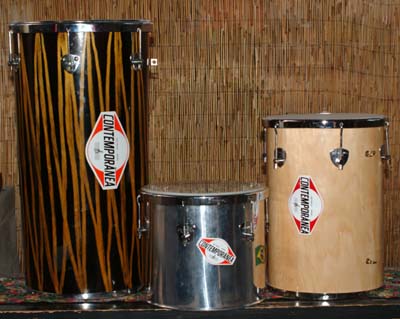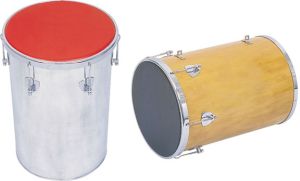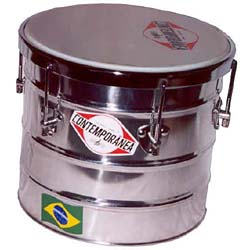 The
Tantan Page The
Tantan Page
[tan tan]
We love Tan Tan, Rebolo, and Repique
de Mao, and we are glad that they are seeing more use here in North
America.
Tan tan is a type of Brazilian bass drum of sorts.[some
would say it is a a baritone or tenor drum, but it functions well
on the low end.] It is the the only one [we know of] to
be played by hand. Other Brazilian bass drums include the Surdo,
Zabumba, and Alfaia. Tantan began mirroring the surdo
in function, but it is definitely finding its own voice and style
as time goes on.
They are single headed, cylindrical or sometimes
conical , ultmately from the same larger family of cylindrical/conical
instruments which includes the surdo, the timba/timbal/timbau, the
caixa, etc..
The immediate family of instruments
includes the large tan tan [usually 28" x 14"], the smaller
rebolo [12" diameter, 18" to 24" in length], and
the smallest of the three, repique de mao [usually either 10"
or 12", but short]. All are used in Pagode music in Brasil.
 In
the Pagode groups we have researched on the Web, we have not seen
the smaller rebolo played along with the tantan. In the case of
Fundo de Quintal, for example, drumset and surdo are present as
well, along with tantan, pandeiro, repique de mao, electronic keyboards,
and the stringed instruments: guitar cavaquiño, and banjo.
those, of course, are big stage situations. Many other venues will
make the rebolo useful, such as smaller stages and live situations
in homes and so on.. In
the Pagode groups we have researched on the Web, we have not seen
the smaller rebolo played along with the tantan. In the case of
Fundo de Quintal, for example, drumset and surdo are present as
well, along with tantan, pandeiro, repique de mao, electronic keyboards,
and the stringed instruments: guitar cavaquiño, and banjo.
those, of course, are big stage situations. Many other venues will
make the rebolo useful, such as smaller stages and live situations
in homes and so on..
These are subtle instruments, not the
drums to use when trying to be heard over a dozen djembe players
flailing away with djun djuns and bells at a big drum circle. They
have a breathy, airy feel to them, as you might expect when thinking
of the column of air sent out with every stroke. In electronic situations,
they must be miked.
Technique -
Basically the drum goes across your lap if you're seated, or strapped
horizontally across you if you are standing. Thiss applies to both
tanTan and rebolo, but to the best of our knowledge, no one marches
with Repique de Mao, and it does not use a strap. (More on Repique
de Mao later. For now, let's look at tantan and rebolo. We have
assembled a page with video examples for you, sort of a grab bag
of patterns to get started. See Patterns
For TanTan.
Heads
The tan tan usually have NAPA heads, which emphasizes
the bass. This is a layer of nylon with another layer of rubbery
naughahide, attached only at the collar of the head. NAPA is good
when you are miked or when not much volume, but much fullness is
required. The extra layer takes out most of the upper harmonics,
leaving a real thick low end.
Playing for dancers outside in the street, even with
only 2 or 3 drummers, we found that a tan tan with a NAPA head sometimes
did not offer enough projection. We began to experiment, and we
realized that when you use other than NAPA heads, the drum begins
to take on a character all its own. the upper harmonics on the edge
of the drum are then more useful.
The calfskin option probably sounds the best when
it is perfectly in tune, but one has to tune literally each time
one sits down to play. It is best approached as a ritual, to focus
before playing, maybe light some incense, breathe deeply and tune;
it really is worth the time. However, in some situations
it isn't practical. To get off a plane or out of a car in bad weather
and be ready to play, better, we think, to use synthetics.
We have successfully used a wide variety of heads.
Both REMO and Evans heads fit most of the time, although the collars
are deeper than the Brazilian nylon, leather, or NAPA. It is a close
call. In one case, with our shorter rebolo (18"x12") we
had to work quite a bit to make a REMO fiberskin head fit onto the
drum. The switch back to a Contemporanea calf head was a wiser choice.
We currently use an Evans head on the striped tan tan in these /Quicktime
examples.
REMO fiberskin worked great on the Contemporanea 28
x14 aluminum tantan at the Gator Bowl, roaming around Gainesville.
Recording video on the move was definitely problematic, though,
because the drum is so directional. often on playback, you can hear
the timba better, and the low end on the recording is never as full
as it seemed live.
 Repique
de Mao Repique
de Mao
Repique de Mao almost always has a nylon head.
The description of how this instrument came about, from Bolão's
excellent book Batuque é um Privelégio:
"Ubirany of the group Fundo de
Quintal, says that one time he didn't have an instrument available
to play and used a tom tom from a drum set that was in the house.
Later, during a Pagode in the rehearsal rea of the carnival group
Cacique de Ramos, and this time he used a normal repique, common
among the Samba schools. Because of the excessive resonance of the
instrument, he decided to take off one of the skins. the result
is the basic instrument that is now called the repique de mao. Placed
on the leg while seated, the repique is played with one of the hands
on the skin, and the other on the shell."
We are still exploring our new repique
de mao, and we will add to this page with more content on it soon.
Stay tuned!
|

